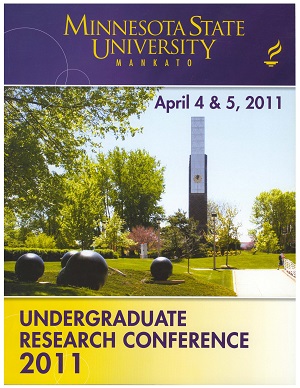Event Title
Production of 13N for Radiotracer Synthesis
Location
CSU 253/4/5
Start Date
4-4-2011 11:00 AM
End Date
4-4-2011 12:30 PM
Student's Major
Physics and Astronomy
Student's College
Science, Engineering and Technology
Mentor's Name
Justen Pautzke
Mentor's Department
Physics and Astronomy
Mentor's College
Science, Engineering and Technology
Second Mentor's Name
Andrew Roberts
Second Mentor's Department
Physics and Astronomy
Second Mentor's College
Science, Engineering and Technology
Description
13N has been produced using a 400KeV Van de Graaff particle accelerator housed in MSU-Mankato‘s Applied Nuclear Science Lab. A custom target system, designed and built in this lab, contains a graphite target connected to an external power supply via insulated feed-throughs. Once 13N has been produced in the 12C(d,n)13N reaction the target is ohmically heated, under an atmosphere of hydrogen or carbon dioxide, with a large supplied current releasing the radioisotope from the carbon matrix. The ensuing reaction with either hydrogen or carbon dioxide forms 13NH3 or HC13N and 13NO2 respectively. Radiolabeled 13N compounds are used for physiological imaging, in both plants and animals, via a technique known as Positron Emission Tomography (PET). While the energies attainable with our accelerator are slightly above threshold resulting in a low yield of 13N, the techniques and procedures developed during this research can be implemented on higher energy accelerator systems.
Production of 13N for Radiotracer Synthesis
CSU 253/4/5
13N has been produced using a 400KeV Van de Graaff particle accelerator housed in MSU-Mankato‘s Applied Nuclear Science Lab. A custom target system, designed and built in this lab, contains a graphite target connected to an external power supply via insulated feed-throughs. Once 13N has been produced in the 12C(d,n)13N reaction the target is ohmically heated, under an atmosphere of hydrogen or carbon dioxide, with a large supplied current releasing the radioisotope from the carbon matrix. The ensuing reaction with either hydrogen or carbon dioxide forms 13NH3 or HC13N and 13NO2 respectively. Radiolabeled 13N compounds are used for physiological imaging, in both plants and animals, via a technique known as Positron Emission Tomography (PET). While the energies attainable with our accelerator are slightly above threshold resulting in a low yield of 13N, the techniques and procedures developed during this research can be implemented on higher energy accelerator systems.
Recommended Citation
Prokop, Christopher; John Clymer; Nick Compton; Henry Dam; and Adam Hanson. "Production of 13N for Radiotracer Synthesis." Undergraduate Research Symposium, Mankato, MN, April 4, 2011.
https://cornerstone.lib.mnsu.edu/urs/2011/poster-session-B/28



